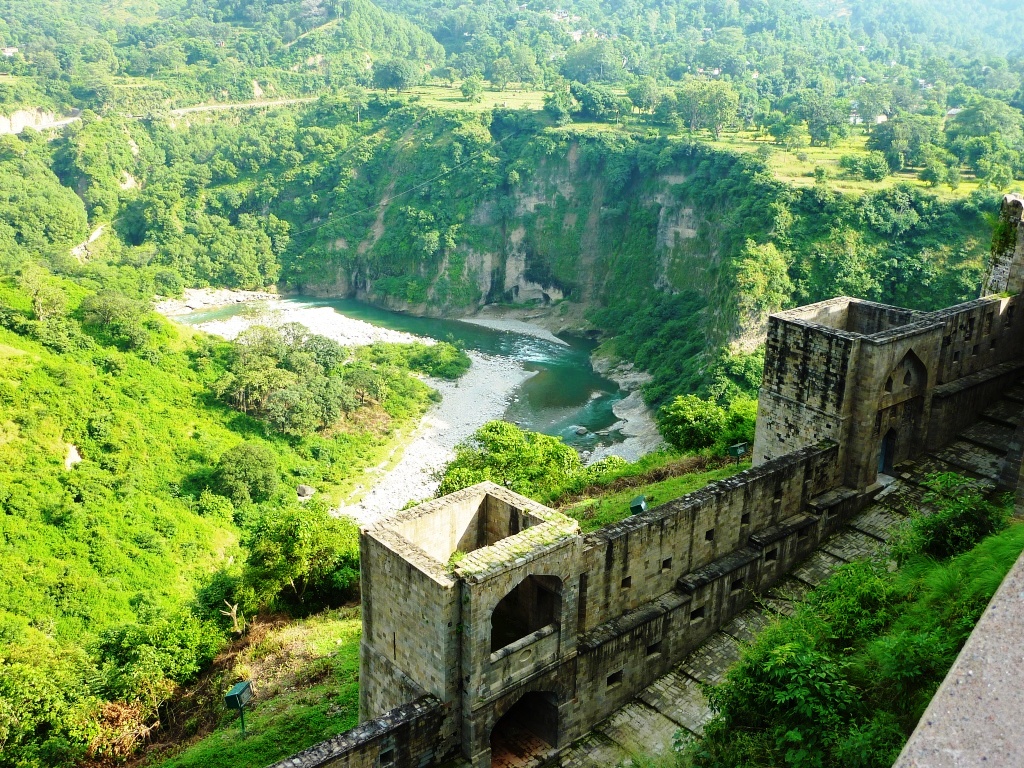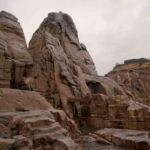The day was overcast and gray with splatters of raindrops now and then on the windscreen. I drove about 20 kms from Dharamshala to reach Kangra town and headed up towards the Kangra fort which is also known as Nagarkot or Kotkangra. The Kangra fort was built by the royal family of Kangra – the Katoch dynasty and was founded by Susharma Chand Katoch. The fort dates back to 1009 A.D. and is probably the oldest dated fort in the Himalayas. It sits atop a hillside with steep drops down to the Banganga river valley, making it a formidable fort; difficult to climb and conquer. The high ramparts and walls cover a circuit of about 4 kilometers.
The history of the fort catalogues that it bore the ravages of conquests by Jahangir (1619 A.D.) – Raja Sansar Chand-II (1786 A.D.)- Maharaja Ranjit Singh (1809 A.D.)- British government (1846 A.D.) and finally the earthquake of April 1905, which lead to a lot of damage to this fort.
I entered through the main gate or the Ranjit Singh Gate. A long, narrow and slopping stepped passage leads to the top of the fort through the Ahani and the Amiri Darwaza- both attributed to Nawab Saif Ali Khan – the first Mughal governor of Kangra.
The passage turns sharply and we found ourselves entering through the Jehangiri Darwaza, out on a pathway, flanked on one side by a garden with lovely sit-outs. The rampart on the other side overlooked the fascinating valley below – view of the gushing streams of Banganga and Manjuli rivers topped by tall, imposing Dhauladhar range.
I walked atop a wooden plank pathway to cross over to the Darsini darwaza, which is flanked by (now defaced) statues of river goddesses Yamuna and Ganga. The door-way lead us to a wide open courtyard where broken bits of stone architecture was arranged and numbered for easy identification.
In the southern side of the courtyard, I could see some carved shrines – these were of Lakshmi -Narayana Sitala and Ambika devi – the family goddess of Katoch dynasty. In between these shrines, a small stepped passage leads up to the main palace.
There are beautiful green spaces, spaced out intermittently to enable the palace residents to enjoy the gorgeous view all around. I could see ruins of chambers and even more steps lead us to the very top of the fort where a group of picnickers was laying out their picnic lunch.
A sudden burst of raindrops made mel dash away to dry and sheltered area. I stayed put till the rain eased a bit and then headed down the fort over wet stones, which had turned slippery and difficult to tread.
I was very much impressed by the overall architecture and the expanse of this gorgeous piece of Indian history and architecture. There is a small museum at the entrance gate of the fort, set amidst a vast stretch of garden, overlooking the valley below. A small shop opposite to the main gate is the guide office for the fort from where one can rent out an audio guide, which catalogs in detail the numbered areas of the fort and tells its history in great detail.
Its heartening to see that the ASI cares for and looks after this piece of history which is tucked away so remotely in Kangra. I just wish it could be on the tourism map to enable more people to be aware of and enjoy this beautiful part of Indian history and architecture.











